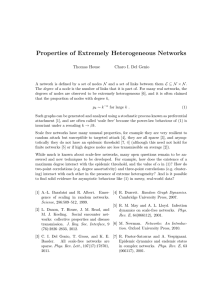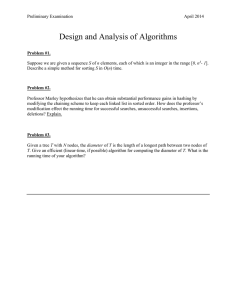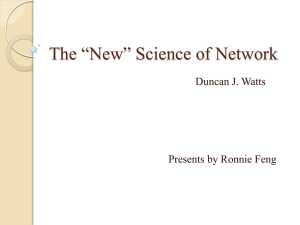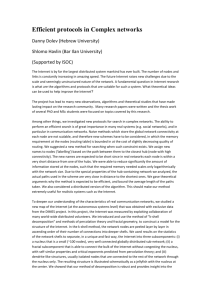Error and attack tolerance of complex networks
advertisement
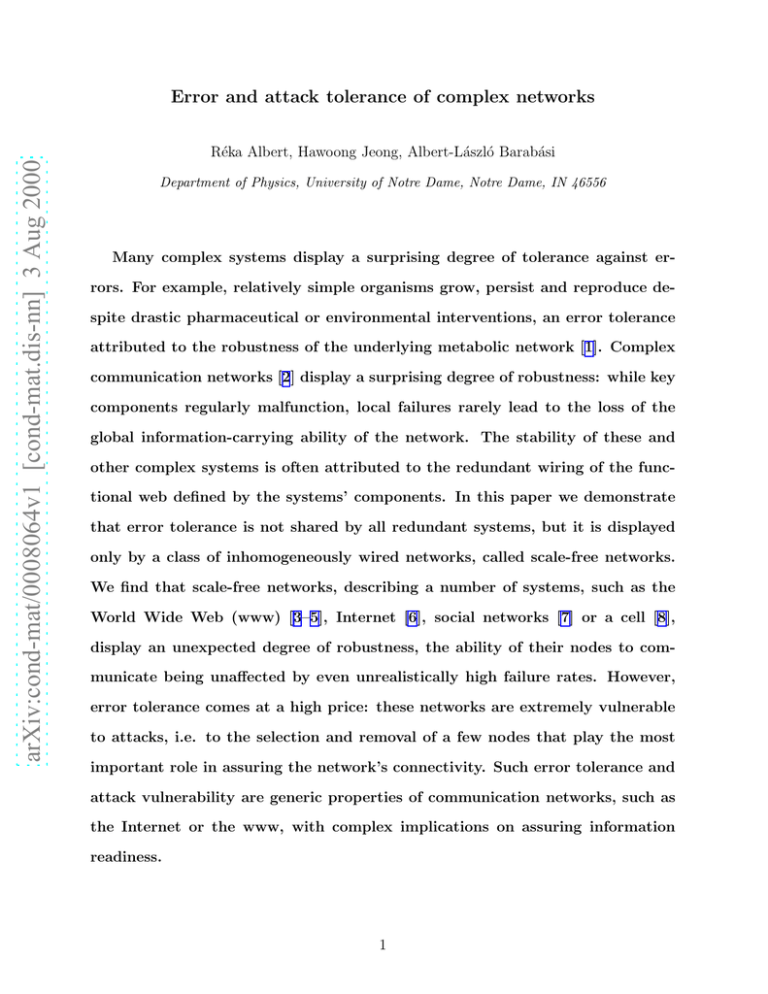
arXiv:cond-mat/0008064v1 [cond-mat.dis-nn] 3 Aug 2000 Error and attack tolerance of complex networks Réka Albert, Hawoong Jeong, Albert-László Barabási Department of Physics, University of Notre Dame, Notre Dame, IN 46556 Many complex systems display a surprising degree of tolerance against errors. For example, relatively simple organisms grow, persist and reproduce despite drastic pharmaceutical or environmental interventions, an error tolerance attributed to the robustness of the underlying metabolic network [1]. Complex communication networks [2] display a surprising degree of robustness: while key components regularly malfunction, local failures rarely lead to the loss of the global information-carrying ability of the network. The stability of these and other complex systems is often attributed to the redundant wiring of the functional web defined by the systems’ components. In this paper we demonstrate that error tolerance is not shared by all redundant systems, but it is displayed only by a class of inhomogeneously wired networks, called scale-free networks. We find that scale-free networks, describing a number of systems, such as the World Wide Web (www) [3–5], Internet [6], social networks [7] or a cell [8], display an unexpected degree of robustness, the ability of their nodes to communicate being unaffected by even unrealistically high failure rates. However, error tolerance comes at a high price: these networks are extremely vulnerable to attacks, i.e. to the selection and removal of a few nodes that play the most important role in assuring the network’s connectivity. Such error tolerance and attack vulnerability are generic properties of communication networks, such as the Internet or the www, with complex implications on assuring information readiness. 1 The increasing availability of topological data on large networks, aided by the computerization of data acquisition, has lead to major advances in our understanding of the generic aspects of network structure and development [9–16]. The existing empirical and theoretical results indicate that complex networks can be divided into two major classes based on their connectivity distribution P (k), giving the probability that a node in the network is connected to k other nodes. The first class of networks is characterized by a P (k) that is peaked at an average hki and decays exponentially for large k. The most investigated examples of such exponential networks are the random graph model of Erdős and Rényi [9,10] and the smallworld model of Watts and Strogatz [11], both leading to a fairly homogeneous network, in which each node has approximately the same number of links, k ≃ hki. In contrast, results on the world-wide web (www) [3–5], Internet [6] and other large networks [17–19] indicate that many systems belong to a class of inhomogeneous networks, referred to as scale-free networks, for which P (k) decays as a power-law, i.e. P (k) ∼ k −γ , free of a characteristic scale. While the probability that a node has a very large number of connections (k >> hki) is practically prohibited in exponential networks, highly connected nodes are statistically significant in scale-free networks (see Fig. 1). We start by investigating the robustness of the two basic network models, the ErdősRényi (ER) model [9,10] that produces a network with an exponential tail, and the scale-free model [17] with a power-law tail. In the ER model we first define the N nodes, and then connect each pair of nodes with probability p. This algorithm generates a homogeneous network (Fig. 1), whose connectivity follows a Poisson distribution peaked at hki and decaying exponentially for k >> hki. The inhomogeneous connectivity distribution of many real networks is reproduced by the scale-free model [17,18] that incorporates two ingredients common to real networks: growth and preferential attachment. The model starts with m0 nodes. At every timestep t a new node is introduced, which is connected to m of the the already existing nodes. The probability Πi that the new node is connected to node i depends on the connectivity ki of 2 that node, such that Πi = ki/ P j kj . For large t the connectivity distribution is a power-law following P (k) = 2m2 /k 3 . The interconnectedness of a network is described by its diameter d, defined as the average length of the shortest paths between any two nodes in the network. The diameter characterizes the ability of two nodes to communicate with each other: the smaller d is, the shorter is the expected path between them. Networks with a very large number of nodes can have a rather small diameter; for example the diameter of the www, with over 800 million nodes [20], is around 19 [3], while social networks with over six billion individuals are believed to have a diameter of around six [21]. To properly compare the two network models we generated networks that have the same number of nodes and links such that P (k) follows a Poisson distribution for the exponential, and a power-law for the scale-free network. Error tolerance— To address the networks’ error tolerance, we study the changes in the diameter when a small fraction f of the nodes is removed. The malfunctioning (absence) of a node in general increases the distance between the remaining nodes, since it can eliminate some paths that contribute to the system’s interconnectedness. Indeed, for the exponential network the diameter increases monotonically with f (Fig. 2a), thus, despite its redundant wiring (Fig. 1), it is increasingly difficult for the remaining nodes to communicate with each other. This behavior is rooted in the homogeneity of the network: since all nodes have approximately the same number of links, they all contribute equally to the network’s diameter, thus the removal of each node causes the same amount of damage. In contrast, we observe a drastically different and surprising behavior for the scale-free network (Fig. 2a): the diameter remains unchanged under an increasing level of errors. Thus even when as high as 5% of the nodes fail, the communication between the remaining nodes in the network is unaffected. This robustness of scale-free networks is rooted in their extremely inhomogeneous connectivity distribution: since the power-law distribution implies that the majority of nodes have only a few links, nodes with small connectivity will be selected with much higher probability, and the removal of these ”small” nodes does not alter the path structure of the remaining nodes, thus has no impact on the overall network topology. 3 Attack survivability— An informed agent that attempts to deliberately damage a network, such as designing a drug to kill a bacterium, will not eliminate the nodes randomly, but will rather target the most connected nodes. To simulate an attack we first remove the most connected node, and continue selecting and removing nodes in the decreasing order of their connectivity k. Measuring the diameter of an exponential network under attack, we find that, due to the homogeneity of the network, there is no substantial difference whether the nodes are selected randomly or in decreasing order of connectivity (Fig. 2a). On the other hand, a drastically different behavior is observed for scale-free networks: when the most connected nodes are eliminated, the diameter of the scale-free network increases rapidly, doubling its original value if 5% of the nodes are removed. This vulnerability to attacks is rooted in the inhomogeneity of the connectivity distribution: the connectivity is ensured by a few highly connected nodes (Fig. 1b), whose removal drastically alters the network’s topology, and decreases the ability of the remaining nodes to communicate with each other. Network fragmentation— When nodes are removed from a network, clusters of nodes, whose links to the system disappear, can get cut off from the main cluster. To better understand the impact of failures and attacks on the network structure, we next investigate this fragmentation process. We measure the size of the largest cluster, S, shown as a fraction of the total system size, when a fraction f of the nodes are removed either randomly or in an attack mode. We find that for the exponential network, as we increase f , S displays a threshold-like behavior such that for f > fc ≃ 0.28 we have S ≃ 0. A similar behavior is observed when we monitor the average size hsi of the isolated clusters (i.e. all the clusters except the largest one), finding that hsi increases rapidly until hsi ≃ 2 at fc , after which it decreases to hsi = 1. These results indicate the following breakdown scenario (Fig. 4): For small f , only single nodes break apart, hsi ≃ 1, but as f increases, the size of the fragments that fall off the main cluster increases, displaying a singular behavior at fc . At fc the system practically falls apart, the main cluster breaking into small pieces, leading to S ≃ 0, and the size of the fragments, hsi, peaks. As we continue to remove nodes (f > fc ), we fragment these isolated clusters, leading to a decreasing hsi. Since the ER model is equivalent to the 4 infinite dimensional percolation [22], the observed threshold behavior is qualitatively similar to the percolation critical point. However, the response of a scale-free network to attacks and failures is rather different (Fig. 3b). For random failures no threshold for fragmentation is observed, rather the size of the largest cluster slowly decreases. The fact that hsi ≃ 1 for most f indicates that the network is deflated by nodes breaking off one by one, the increasing error level leading to the isolation of single nodes only, not clusters of nodes. Thus, in contrast with the catastrophic fragmentation of the exponential network at fc , the scale-free network stays together as a large cluster for very high values of f , providing additional evidence of the topological stability of these networks under random failures. This behavior is consistent with the existence of an extremely delayed critical point (Fig. 3), the network falling apart only after the main cluster has been completely deflated. On the other hand, the response to attack of the scale-free network is similar (but swifter) to the response to attack and failure of the exponential network (Fig. 3b): at a critical threshold fcsf ≃ 0.18, smaller than the value fce ≃ 0.28 observed for the exponential network, the system breaks apart, forming many isolated clusters (Fig. 4). While great efforts are being made to design error tolerant and low yield components for communication systems, little is known about the effect of the errors and attacks on the large-scale connectivity of the network. To demonstrate the impact of our model based studies to these systems, next we investigate the error and attack tolerance of two networks of increasing economic and strategic importance: the Internet and the www. Recently Faloutsos et al. [6] investigated the topological properties of the Internet at the router and inter-domain level, finding that the connectivity distribution follows a power-law, P (k) ∼ k −2.48 . Consequently, we expect that it should display the error tolerance and attack vulnerability predicted by our study. To test this, we used the latest survey of the Internet topology, giving the network at the inter-domain (autonomous system) level. Indeed, we find that the diameter of the Internet is unaffected by the random removal of as high as 2.5% of the nodes (an order of magnitude larger than the failure rate (0.33%) of the Internet routers 5 [23]), while if the same percentage of the most connected nodes are eliminated (attack), d more than triples (Fig. 2b). Similarly, the large connected cluster persists for high rates of random node removal, but if nodes are removed in the attack mode, the size of the fragments that break off increases rapidly, the critical point appearing at fcI ≃ 0.03 (Fig. 3b). The www forms a huge directed graph whose nodes are documents and edges are the URL hyperlinks that point from one document to another, its topology determining the search engines’ ability to locate information on it. The www is also a scale-free network: the probabilities Pout (k) and Pin (k) that a document has k outgoing and incoming links follow a power-law over several orders of magnitude, i.e. P (k) ∼ k −γ , with γin = 2.1 and γout = 2.45 [3,4,24]. Since no complete topological map of the www is available, we limited our study to a subset of the web containing 325, 729 nodes and 1, 469, 680 links (hki = 4.59) [3]. Despite the directedness of the links, the response of the system is similar to the undirected networks we investigated earlier: after a slight initial increase, d remains constant in the case of random failures, while it increases for attacks (see Fig. 2c). The network survives as a large cluster under high rates of failure, but the behavior of hsi indicates that under attack the system abruptly falls apart at fcw = 0.067 (Fig. 3c). In summary, we find that scale-free networks display a surprisingly high degree of tolerance against random failures, a property not shared by their exponential counterparts. This robustness is probably the basis of the error tolerance of many complex systems, ranging from cells [8] to distributed communication systems. It also explains why, despite frequent router problems [23], we rarely experience global network outages or, despite the temporary unavailability of many webpages, our ability to surf and locate information on the web is unaffected. However, the error tolerance comes at the expense of attack survivability: the diameter of these networks increases rapidly and they break into many isolated fragments when the most connected nodes are targeted. Such decreased attack survivability is useful for drug design [8], but it is less encouraging for communication systems, such as the Internet or the www. While the general wisdom is that attacks on networks with distributed resource management are less successful, our results indicate that the topological weaknesses of the 6 current communication networks, rooted in their inhomogeneous connectivity distribution, have serious effects on their attack survivability, that could be exploited by those seeking to damage these systems. 7 REFERENCES [1] Hartwell, L. H., Hopfield, J. J., Leibler, S. & Murray, A. W., From molecular to modular cell biology, Nature 402, C47-C52 (1999). [2] Claffy, K., Monk, T. E. & McRobb, D. Internet tomography, Nature web matters, 7 January 1999, <http://helix.nature.com/webmatters/tomog/tomog.html>. [3] Albert, R., Jeong, H. & Barabási, A.-L. Diameter of the World-Wide Web, Nature 401, 130-131 (1999). [4] Kumar, R., Raghavan, P., Rajalopagan, S. & Tomkins, A. Extracting large-scale knowledge bases from the web, Proc. 25th VLDB Conf., Edinburgh, 1999. [5] Huberman, B. A. & Adamic, L. A. Growth dynamics of the World-Wide Web, Nature 401, 131 (1999). [6] Faloutsos, M., Faloutsos, P. & Faloutsos, C. On Power-Law Relationships of the Internet Topology, ACM SIGCOMM ’99, Comput. Commun. Rev. 29, 251-263 (1999). [7] Wasserman, S. & Faust, K. Social Network Analysis (Cambridge University Press, Cambridge, 1994). [8] Jeong, H., Tombor, B., Albert, R., Oltvai, Z. & Barabási, A.-L. The large-scale organization of metabolic networks. (preprint). [9] Erdős, P. & Rényi, A. On the evolution of random graphs. Publ. Math. Inst. Hung. Acad. Sci. 5, 17-60 (1960). [10] Bollobás, B. Random Graphs (Academic Press, London, 1985). [11] Watts, D. J. & Strogatz, S. H. Collective dynamics of ’small-world’ networks. Nature 393, 440-442 (1998). [12] Zegura, E. W., Calvert, K. L. & Donahoo, M. J. A Quantitative Comparison of Graph- 8 based Models for Internet Topology. IEEE/ACM Transactions on Networking 5, 770-787 (1997). [13] Cohen, J. E., Briand, F. & Newman, C. M. Community food webs: data and theory (Springer-Verlag, Berlin 1990). [14] Maritan, A., Colaiori, F., Flammini, A., Cieplak, M., & Banavar, J. Universality Classes of Optimal Channel Networks. Science 272, 984-986 (1996). [15] Banavar, J. R., Maritan, A. & Rinaldo, A. Size and form in efficient transportation networks. Nature 399, 130-132 (1999). [16] Barthélémy, M. & Amaral, L. A. N. Small-World Networks: Evidence for a Crossover Picture. Phys. Rev. Lett. 82, 3180-3183 (1999). [17] Barabási, A.-L. & Albert, R. Emergence of Scaling in Random Networks. Science 286, 509-511 (1999). [18] Barabási, A.-L., Albert, R. & Jeong, H. Mean-field theory for scale-free random networks. Physica 272A, 173-187 (1999). [19] Redner, S., How popular is your paper? An empirical study of the citation distribution. Euro. Phys. J. B 4, 131-134 (1998). [20] Lawrence, S. & Giles, C. L. Accessibility of information on the web. Nature 400, 107-109 (1999). [21] S. Milgram, The Small-World Problem. Psychol. Today 2, 60-67 (1967). [22] Bunde, A. & Havlin S. (editors) Fractals and Disordered Systems (Springer, New York, 1996). [23] Paxson, V. End-to-End Routing Behavior in the Internet. IEEE/ACM Transactions on Networking 5, 601-618 (1997). 9 [24] Adamic, L. A. The Small World Web. Lect. Notes Comput. Sci 1696, 443-452 (1999). 10 FIGURES FIG. 1. Visual illustration of the difference between an exponential and a scale-free network. The exponential network a is rather homogeneous, i.e. most nodes have approximately the same number of links. In contrast, the scale-free network b is extremely inhomogeneous: while the majority of the nodes have one or two links, a few nodes have a large number of links, guaranteeing that the system is fully connected. We colored with red the five nodes with the highest number of links, and with green their first neighbors. While in the exponential network only 27% of the nodes are reached by the five most connected nodes, in the scale-free network more than 60% are, demonstrating the key role the connected nodes play in the scale-free network. Note that both networks contain 130 nodes and 215 links (hki = 3.3). The network visualization was done using the Pajek program for large network analysis <http://vlado.fmf.uni-lj.si/pub/networks/pajek/pajekman.htm>. 11 12 a E SF 10 Failure Attack 8 d 6 4 0.00 0.02 0.04 c b 15 Internet 10 20 www Attack Attack 15 5 Failure 0 0.00 0.01 0.02 Failure 10 0.00 0.01 0.02 f FIG. 2. Changes in the diameter of the network as a function of the fraction of the removed nodes. a, Comparison between the exponential (E) and scale-free (SF) network models, each containing N = 10, 000 nodes and 20, 000 links (i.e. hki = 4). The blue symbols correspond to the diameter of the exponential (triangles) and the scale-free (squares) network when a fraction f of the nodes are removed randomly (error tolerance). Red symbols show the response of the exponential (diamonds) and the scale-free (circles) networks to attacks, when the most connected nodes are removed. We determined the f dependence of the diameter for different system sizes (N = 1, 000, 5, 000, 20, 000) and found that the obtained curves, apart from a logarithmic size correction, overlap with those shown in a, indicating that the results are independent of the size of the system. Note that the diameter of the unperturbed (f = 0) scale-free network is smaller than that of the exponential network, indicating that scale-free networks use more efficiently the links available to them, generating a more interconnected web. b, The changes in the diameter of the Internet under random failures (squares) or attacks (circles). We used the topological map of the Internet, containing 6, 209 nodes and 12, 200 links (hki = 3.4), collected by the National Laboratory for Applied Network Research <http://moat.nlanr.net/Routing/rawdata/>. c, Error (squares) and attack (circles) survivability of the world-wide web, measured on a sample containing 325, 729 nodes and 1, 498, 353 links [3], such that hki = 4.59. 12 2 a b 2 E 1 SF 0 0.0 S <s> 1 ❑ ■ Failure ❍ ● Attack <s> and S 0.2 0.8 1 fc fc 0 0.0 0.4 0 0.0 3 0.4 c 0.2 0.4 10 d 10 2 1 10 WWW < 1 0 1 Internet 0 0.0 2 0 0.00 0.1 0.04 0.08 10 -1 0.12 f FIG. 3. Network fragmentation under random failures and attacks. The relative size of the largest cluster S (open symbols) and the average size of the isolated clusters hsi (filled symbols) in function of the fraction of removed nodes f for the same systems as in Fig. 2. The size S is defined as the fraction of nodes contained in the largest cluster (i.e. S = 1 for f = 0). a, Fragmentation of the exponential network under random failures (squares) and attacks (circles). b, Fragmentation of the scale-free network under random failures (blue squares) and attacks (red circles). The inset shows the error tolerance curves for the whole range of f , indicating that the main cluster falls apart only after it has been completely deflated. Note that the behavior of the scale-free network under errors is consistent with an extremely delayed percolation transition: at unrealistically high error rates (fmax ≃ 0.75) we do observe a very small peak in hsi (hsmax i ≃ 1.06) even in the case of random failures, indicating the existence of a critical point. For a and b we repeated the analysis for systems of sizes N = 1, 000, 5, 000, and 20, 000, finding that the obtained S and hsi curves overlap with the one shown here, indicating that the overall clustering scenario and the value of the critical point is independent of the size of the system. Fragmentation of the Internet (c) and www (d), using the topological data described in Fig. 2. The symbols are the same as in b. Note that hsi in d in the case of attack is shown on a different scale, drawn in the right side of the frame. While for small f we have hsi ≃ 1.5, at fcw = 0.067 the average fragment size abruptly increases, peaking at hsmax i ≃ 60, then decays rapidly. For the attack curve in d we ordered the nodes in function of the number of outgoing links, kout . Note that while the three studied networks, the scale-free model, the Internet and the www have different γ, hki and clustering coefficient [11], their response to attacks and errors is identical. Indeed, we find that the difference between these quantities changes only fc and the magnitude of d, S and hsi, but not the nature of the response of these networks to perturbations. 13 10 10 0 -2 -4 Scale-free network (www, Internet) 0 b -2 10 0 10 c f=0.45 f=0.18 10 -4 -1 -6 10 Exponential network 10 f=0.05 10 10 10 a 0 10 2 10 4 10 0 10 1 10 2 10 3 0 2 4 Attack Failure ck a t At fc Failure 10 10 10 0 10 d 10 f=0.05 -2 10 -4 10 0 10 2 10 0 4 -2 e 10 f=0.18 10 10 0 10 2 f≈0.18 f≈0.05 10 4 f -2 10 -4 0 10 f=0.45 -4 -6 0 1 2 10 10 10 10 3 f≈0.45 FIG. 4. Summary of the response of a network to failures or attacks. The insets show the cluster size distribution for various values of f when a scale-free network of parameters given in Fig. 3b is subject to random failures (a-c) or attacks (d-f). Upper panel: Exponential networks under random failures and attacks and scale-free networks under attacks behave similarly: for small f clusters of different sizes break down, while there is still a large cluster. This is supported by the cluster size distribution: while we see a few fragments of sizes between 1 and 16, there is a large cluster of size 9, 000 (the size of the original system being 10, 000). At a critical fc (see Fig. 3) the network breaks into small fragments between sizes 1 and 100 (b) and the large cluster disappears. At even higher f (c) the clusters are further fragmented into single nodes or clusters of size two. Lower panel: Scale-free networks follow a different scenario under random failures: The size of the largest cluster decreases slowly as first single nodes, then small clusters break off. Indeed, at f = 0.05 only single and double nodes break off (d). At f = 0.18, when under attack the network is fragmented (b), under failures the large cluster of size 8, 000 coexists with isolated clusters of size 1 through 5 (e). Even for unrealistically high error rate of f = 0.45 the large cluster persists, the size of the broken-off fragments not exceeding 11 (f). 14
